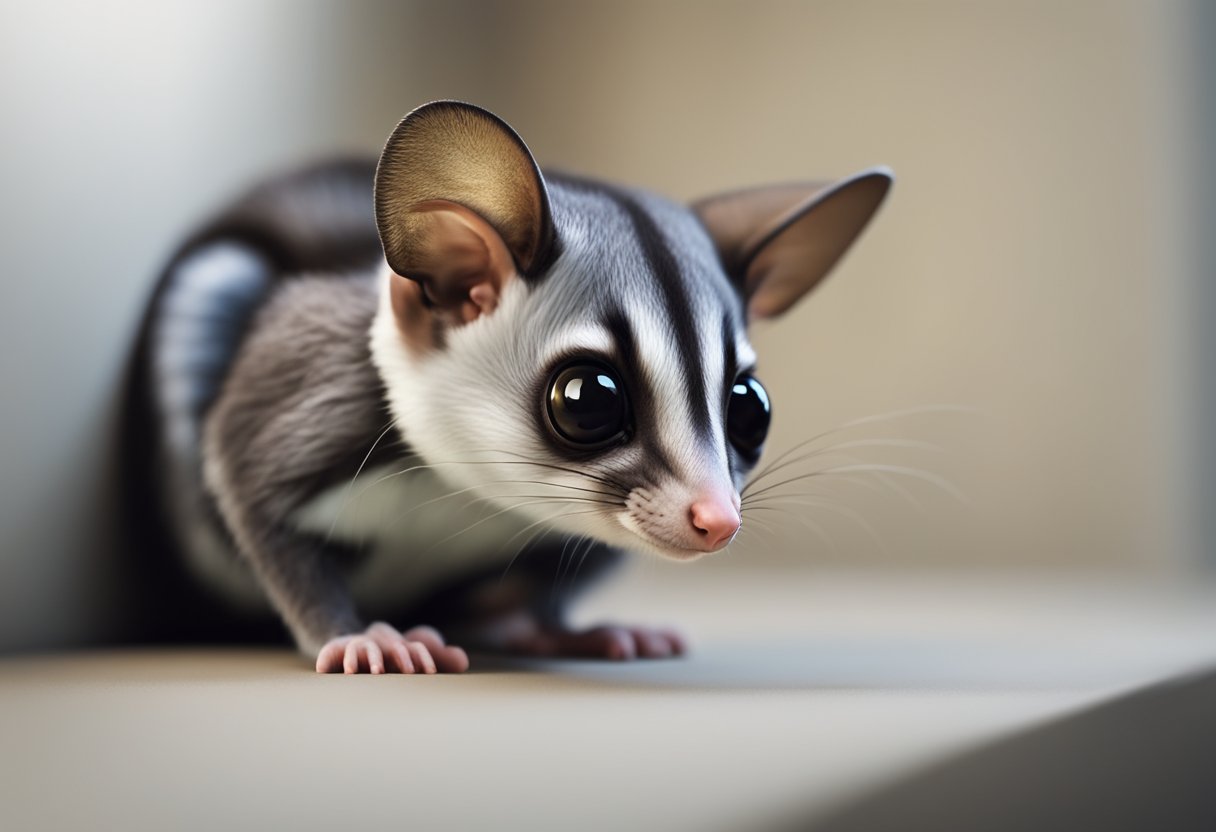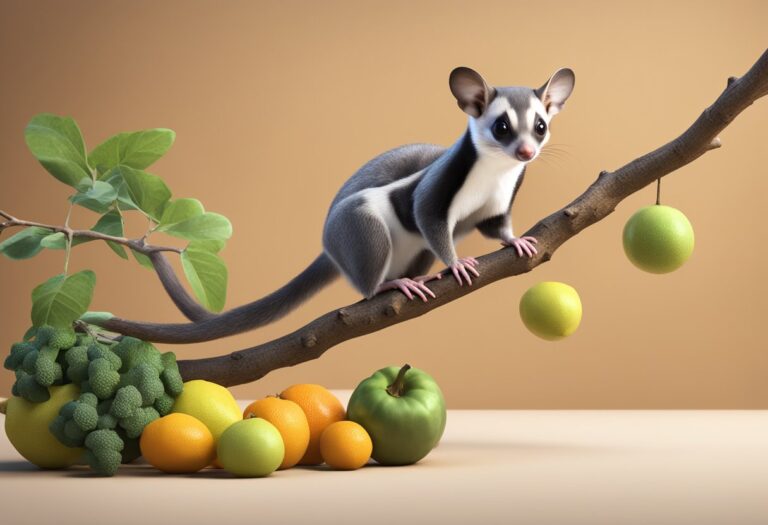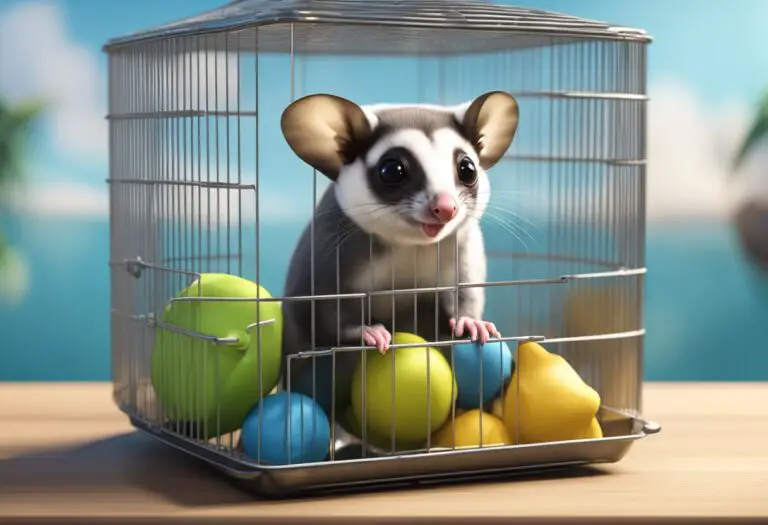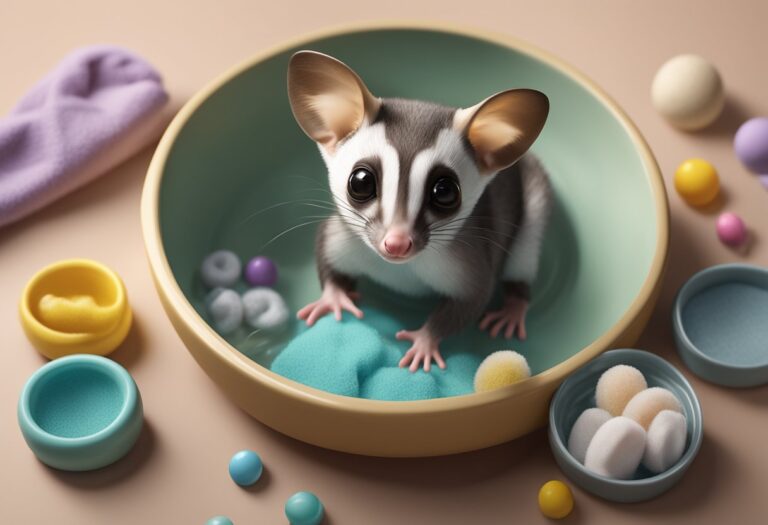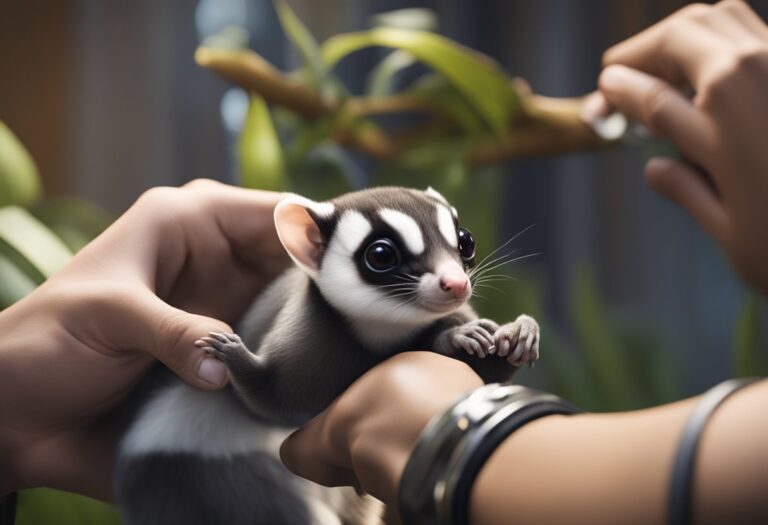Stress Signs in Sugar Gliders: Identifying Key Indicators
Did you know that a staggering 85% of sugar gliders in captivity exhibit signs of stress at some point in their lives? As delicate and sensitive creatures, sugar gliders require a meticulous level of care and attention to thrive. This comprehensive guide will help sugar glider owners and enthusiasts identify the key signs and indicators of stress in their beloved pets.
By understanding the various behavioral, physical, and environmental factors that can contribute to stress in sugar gliders, readers will be better equipped to recognize and address any issues early on, ensuring the overall health and well-being of these unique and delicate creatures. The article will cover a wide range of stress-related topics, from changes in behavior and physical symptoms to environmental stressors and appropriate management techniques. With this knowledge, sugar glider owners can create a nurturing and stress-free environment for their furry companions.
Understanding the Importance of Recognizing Stress in Sugar Gliders
Recognizing stress in sugar gliders is crucial, as it can have a significant impact on their physical and mental well-being. Sugar glider stress indicators and other sugar glider health issues can arise from high stress levels, leading to compromised immune systems, digestive problems, and even behavioral changes that can negatively affect the sugar glider’s quality of life. By understanding the various signs and indicators of sugar glider stress, owners can take proactive measures to identify and address any issues early on, before they escalate into more serious conditions.
Impact of Stress on Sugar Glider Health
Stress can have far-reaching consequences for sugar gliders, contributing to a host of health problems. When sugar gliders experience prolonged or severe sugar glider anxiety or sugar glider depression, their immune systems can become compromised, making them more susceptible to infections and other illnesses. Stress can also disrupt the sugar glider’s digestive system, leading to issues such as diarrhea or loss of appetite. Additionally, stress-induced behavioral changes, such as increased aggression or self-mutilation, can further compromise the sugar glider’s overall well-being.
Early Detection: The Key to Effective Intervention
Early detection and intervention are essential for maintaining the health and happiness of sugar gliders. By closely monitoring their sugar glider stress indicators and promptly addressing any signs of distress, owners can prevent stress from escalating into more severe problems. Prompt action and appropriate sugar glider care measures can help mitigate the impact of stress and ensure that sugar gliders continue to thrive.
Sugar Glider Behavior Changes: Clues to Stress

Sugar gliders are typically known for their playful and social nature, but changes in their behavior can be a clear indication of underlying stress. One of the most obvious signs of stress in sugar gliders is increased aggression or biting, which may be directed towards their owners or cage mates. This aggressive behavior can stem from a variety of factors, including anxiety, fear, or a perceived threat within the sugar glider’s environment.
Increased Aggression or Biting
When a sugar glider is experiencing heightened levels of stress, they may become more aggressive, exhibiting behaviors such as hissing, biting, or lunging at their owners or other animals in their surroundings. This shift in demeanor can be particularly concerning, as it not only poses a risk to the well-being of the sugar glider but also to those interacting with the animal. Identifying and addressing the root causes of this aggression is crucial for maintaining a safe and harmonious environment for all.
Loss of Appetite or Refusal to Eat
Another concerning sign of stress in sugar gliders is a loss of appetite or a refusal to eat. This can be a particularly worrying symptom, as it can lead to malnutrition and other health complications if left unchecked. A sugar glider that is experiencing high levels of stress may simply lose interest in their food, or they may actively avoid or refuse to consume their regular diet. Monitoring a sugar glider’s eating habits and addressing any changes in their appetite can help ensure their overall well-being and prevent more serious health issues from developing.
Excessive Grooming or Self-Mutilation
Excessive grooming or self-mutilation, such as over-grooming or pulling out fur, can also be a clear indication that a sugar glider is experiencing heightened levels of stress. This behavior can stem from a variety of factors, including anxiety, boredom, or a need to self-soothe. By recognizing these behavioral changes, sugar glider owners can take immediate action to identify and address the root causes of the stress, ensuring the overall health and well-being of their furry companions.
Physical Symptoms of Stress in Sugar Gliders
Stress in sugar gliders can also manifest through physical symptoms, which can be equally important indicators of their well-being. One common physical sign of stress is the presence of diarrhea or abnormal stools, which can be a result of digestive issues or disruptions to the sugar glider’s normal bodily functions.
Diarrhea or Abnormal Stools
Diarrhea or changes in the consistency and frequency of a sugar glider’s stools can be a clear indicator that the animal is experiencing stress. These digestive issues may stem from underlying health problems or be a direct response to environmental or emotional stressors.
Lethargy and Lack of Energy
Additionally, lethargy and a lack of energy can be a tell-tale sign that a sugar glider is experiencing high levels of stress, as their natural energetic and playful behaviors may become diminished. Sugar gliders are typically known for their active and curious nature, so a noticeable decrease in activity levels can signal that something is amiss.
Recognizing these physical symptoms can help sugar glider owners take appropriate action to address the underlying causes of the stress and ensure the overall health and comfort of their pets.
Stress Signs in Sugar Gliders
Sugar gliders are known for their unique vocalizations, which can serve as valuable indicators of their emotional state. Changes in vocalization patterns, such as increased or unusual sounds, can be a sign that a sugar glider is experiencing stress. Additionally, excessive hiding or avoidance of social interaction, which is typically a hallmark of their social nature, can also be a clear indicator of stress. Paying close attention to these subtle changes in a sugar glider’s behavior and body language can help owners identify and address any potential sources of stress in a timely manner.
Abnormal Vocalization Patterns
Sugar gliders are highly vocal animals, and their vocalizations can range from soft chirps to loud barks. However, changes in the frequency, intensity, or pattern of these sounds can be a sign that a sugar glider is experiencing anxiety or stress. Owners should listen for any unusual or excessive vocalizations, as they may indicate that their pet is feeling distressed or uncomfortable.
Excessive Hiding or Avoiding Social Interaction
Sugar gliders are typically social animals, enjoying the company of their owners and cage mates. However, excessive hiding or avoidance of social interaction can be a clear indicator of stress. If a sugar glider spends an abnormal amount of time in their hiding spot or refuses to engage with their environment and companions, it may be a sign that they are experiencing heightened levels of anxiety or discomfort.
Environmental Stressors for Sugar Gliders
Sugar gliders are highly sensitive creatures, and their living environment can significantly impact their overall well-being. Inadequate housing or a lack of appropriate enrichment and stimulation can be a major source of stress for these animals. Overcrowding, insufficient space, or a dearth of engaging toys and climbing structures can lead to heightened anxiety and behavioral issues in sugar gliders.
Inadequate Housing or Lack of Enrichment
Ensuring that sugar gliders have access to a spacious, well-designed habitat is crucial for their sugar glider care and overall sugar glider environment. A cramped or barren enclosure can contribute to sugar glider stress indicators, as these active and curious animals require ample space to move, explore, and engage in their natural behaviors.
Changes in Routine or Surroundings
Sugar gliders thrive on consistency and familiarity, and any disruptions to their routine or living space can trigger stress responses. Whether it’s a move to a new home, the introduction of new people or animals, or even rearrangements within their existing habitat, these changes can significantly impact a sugar glider’s sense of security and well-being.
Exposure to Loud Noises or Disturbances
In addition to their sensitivity to changes in their environment, sugar gliders are also highly responsive to loud noises and disturbances. Exposure to household appliances, sudden noises, or other disruptive stimuli can contribute to elevated sugar glider stress indicators, leading to behavioral changes and potential health issues.
By understanding and addressing these sugar glider environment and sugar glider care considerations, sugar glider owners can create a more nurturing and stress-free living space for their beloved pets, promoting their overall well-being and happiness.
Identifying Stress in Different Life Stages of Sugar Gliders
The signs and symptoms of stress in sugar gliders can vary depending on their life stage. Understanding the unique stress considerations for each phase of a sugar glider’s life is crucial for providing the appropriate care and support.
Stress in Baby Sugar Gliders (Joeys)
Baby sugar gliders, known as joeys, may be particularly vulnerable to stress as they undergo the crucial developmental stages of their early life. Owners should be vigilant in monitoring for signs of stress, such as poor weight gain, lack of parental care, or abnormal behaviors. Addressing stress in joeys is essential for their healthy growth and well-being.
Stress in Adult Sugar Gliders
As sugar gliders reach adulthood, they may exhibit different stress indicators, such as changes in social interactions or increased aggression. Owners should be attuned to any shifts in their pet’s typical behavior patterns, as these can be early warning signs of stress. Providing a stable, enriched environment and maintaining consistent routines can help adult sugar gliders cope with stress more effectively.
Stress in Elderly Sugar Gliders
As sugar gliders age, they may become more susceptible to stress-related health issues, requiring even greater attention from their owners. Owners should closely monitor their senior sugar gliders for signs of stress, such as decreased mobility, loss of appetite, or changes in sleep patterns. Prompt veterinary care and tailored management strategies can help elderly sugar gliders maintain their well-being and quality of life.
Managing and Reducing Stress in Sugar Gliders
Once the signs of stress in sugar gliders have been identified, it is crucial to take proactive steps to manage and reduce their stress levels. One effective approach is to provide environmental enrichment, such as introducing new toys, climbing structures, and hiding spots, which can help stimulate the sugar glider’s natural behaviors and reduce boredom or anxiety.
Establishing a Consistent Routine
Establishing a consistent daily routine can also be highly beneficial for sugar gliders, as it helps them feel secure and reduces the impact of unexpected changes. By maintaining a predictable schedule for feeding, playtime, and other activities, sugar glider owners can create a sense of stability and comfort for their pets.
Providing Appropriate Diet and Hydration
Additionally, ensuring that sugar gliders have access to a proper diet and adequate hydration can help support their overall health and resilience, making them less susceptible to stress-induced issues. A well-balanced and nutritious diet, along with a reliable source of fresh water, can play a crucial role in maintaining the sugar glider’s physical and mental well-being.
By implementing these stress-reducing strategies, sugar glider owners can help create a nurturing and comfortable environment for their pets, promoting overall health and reducing the negative impacts of stress.
Sugar Glider Body Language: Decoding the Signs
Sugar gliders communicate a great deal through their body language, and understanding these subtle cues can be incredibly helpful in identifying and addressing stress. One key indicator is the positioning and movement of the sugar glider’s tail, which can range from a relaxed, curled position to a more rigid, upright stance that may signal stress or anxiety.
Tail Positioning and Movement
A sugar glider’s tail can provide valuable insights into their emotional state. When relaxed and content, the tail is often curled loosely around the body or hanging in a natural, flexible position. However, a tense, upright tail or rapid, agitated movements may indicate that the sugar glider is experiencing stress or anxiety. Owners should be attentive to any changes in their pet’s tail positioning and movement, as these can serve as early warning signs of stress.
Facial Expressions and Ear Positioning
In addition to the tail, a sugar glider’s facial expressions and ear positioning can also provide valuable insights into their behavior and emotional state. A relaxed, alert expression with ears pointing forward often suggests a calm and content sugar glider. Conversely, a more tense or fearful expression, characterized by flattened ears or a furrowed brow, may indicate stress or discomfort. By closely observing these subtle facial cues, sugar glider owners can gain a deeper understanding of their pet’s needs and respond accordingly to mitigate any sources of stress.
When to Seek Veterinary Assistance for Stressed Sugar Gliders
While sugar glider owners can often address minor stress-related issues through environmental modifications and behavioral interventions, there may be times when professional veterinary assistance is necessary. If a sugar glider is exhibiting persistent or severe stress symptoms, such as ongoing aggression, refusal to eat, or significant changes in physical appearance or behavior, it is important to seek the guidance of an experienced exotic animal veterinarian.
Persistent or Severe Stress Symptoms
When a sugar glider’s stress levels become severe or persistent, it can have serious implications for their overall health and well-being. Owners should be vigilant in monitoring for signs like continuous aggression, prolonged lack of appetite, or dramatic physical changes, as these may indicate the need for immediate veterinary intervention.
Ruling Out Underlying Medical Conditions
In some cases, underlying medical conditions can manifest as stress-related behaviors in sugar gliders. A qualified veterinarian can perform a thorough examination and diagnostic testing to rule out any underlying health issues that may be contributing to the animal’s stress. By addressing any potential medical concerns, the veterinarian can help determine the most appropriate course of treatment to manage the sugar glider’s stress and ensure their optimal health and well-being.
By working closely with a skilled exotic animal veterinarian, sugar glider owners can ensure their pets receive the necessary care and support to manage stress-related issues and maintain optimal health. This collaborative approach can be crucial in identifying and addressing the root causes of stress, allowing sugar gliders to thrive in a nurturing and supportive environment.
Creating a Stress-Free Environment for Sugar Gliders
Providing a stress-free environment for sugar gliders is essential for their overall well-being. This involves ensuring that their living space, or cage, is designed and set up to meet their specific needs, with ample space, appropriate enrichment, and a comfortable temperature and humidity range.
Proper Cage Setup and Habitat Design
The cage or enclosure for sugar gliders should be spacious, with plenty of vertical space to allow for their natural climbing and gliding behaviors. Incorporating various perches, branches, and platforms can create a stimulating and enriched environment. Additionally, maintaining the right temperature and humidity levels is crucial, as these environmental factors can significantly impact a sugar glider’s stress levels.
Socialization and Bonding Techniques
Proper socialization and bonding techniques can also help sugar gliders feel secure and reduce stress-inducing behaviors. This may include regular handling, positive reinforcement training, and introducing new experiences in a gradual and controlled manner. By creating a nurturing and enriched environment, sugar glider owners can help their pets thrive and minimize the risk of stress-related health issues.
Conclusion
In conclusion, recognizing and addressing stress in sugar gliders is crucial for their overall health and well-being. By understanding the various behavioral, physical, and environmental indicators of stress, sugar glider owners can take proactive steps to identify and mitigate any sources of stress. From monitoring changes in behavior and physical symptoms to providing a stress-free living environment and seeking veterinary assistance when necessary, this comprehensive guide has outlined the key strategies for ensuring the long-term happiness and vitality of these unique and delicate pets.
By prioritizing the early detection and management of stress, sugar glider owners can help their furry companions live fulfilling and stress-free lives. Maintaining a deep understanding of the stress signs in sugar gliders, effectively managing their sugar glider care, and creating a nurturing sugar glider environment are essential for promoting their overall sugar glider health. With this knowledge, sugar glider enthusiasts can provide their beloved pets with the care and support they deserve, ensuring their well-being and enriching the bond between owner and animal.

